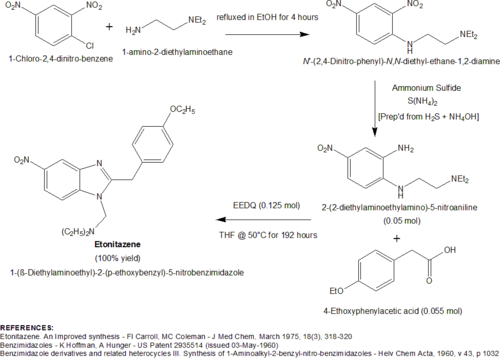Etonitazene
 | |
 | |
| Clinical data | |
|---|---|
| ATC code |
|
| Legal status | |
| Legal status |
|
| Identifiers | |
| |
JSmol) | |
| |
| |
| | |
Etonitazene, also known as EA-4941 or CS-4640,
Because it is characterized by a strong
Synthesis
Etonitazene and its related
The first method involved the condensation of
The most versatile synthesis
A particularly novel, high-yielding synthesis of etonitazene was developed by FI Carroll and MC Coleman in the mid-1970s
A 2011 publication
Analogs
A number of analogues are known, with the only other well-known compound to come out of the original 1950s research being
Of these analogues, only etonitazene and clonitazene are explicitly listed under UN conventions and so are controlled throughout the world. The rest would only be illegal in countries such as the US, Australia and New Zealand that have laws equivalent to the
Illicit production
Illicit production and sale of etonitazene has been limited. Identified on the
See also
- Etazen(desnitroetonitazene)
References
- ^ Anvisa (2023-03-31). "RDC Nº 784 - Listas de Substâncias Entorpecentes, Psicotrópicas, Precursoras e Outras sob Controle Especial" [Collegiate Board Resolution No. 784 - Lists of Narcotic, Psychotropic, Precursor, and Other Substances under Special Control] (in Brazilian Portuguese). Diário Oficial da União (published 2023-04-04). Archived from the original on 2023-08-03. Retrieved 2023-08-16.
- ^ King JW, Cleveland JP, Lennox WJ (November 1991). Williams JD, Reeves PJ (eds.). Synthesis and Bioactivity of 2-(Alpha-Hydroxy-Para-Alkoxybenzyl) and 2-Alkoxy Arylamino Analogs of Etonitazene (CS - 4640). Proceedings of the U.S. Army Chemical Research, Development and Engineering Center Scientific Conference on Chemical Defense Research. Aberdeen Proving Ground, Maryland: Edgewood Research, Development and Engineering Center, Aberdeen Proving Ground, MD.
- ^ US patent 2935514, Hoffmann K, Hunger A, Kebrle J, Rossi A, "Benzimidazoles", published 1957-09-19, issued 1960-05-03, assigned to Ciba Pharmaceutical Products Inc., Summit, NJ.
- S2CID 38073529.
- ^ S2CID 32179439.
- ^ .
- .
- .
- .
- S2CID 6824038.
- ^ .
- PMID 237125.
- PMID 22034860.
- S2CID 208187034.
- S2CID 234646245.
- ^ Sorokin VI, Ponkratov KV, Drozdov MA (1999). "Etonitazene Encountered in Moscow". Microgram. 32 (9): 239–244.
- ^ Reavy P (3 June 2003). "Chemist charged in drug case". Deseret News. Salt Lake City. Archived from the original on March 7, 2014.
- ^ "Этонитазен (etonitazene) - описание препарата" [Etonitazene (etonitazene) - a description of the drug] (in Russian). Social Services LLC. Archived from the original on 23 March 2019.
- PMID 10844102.




